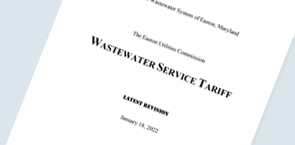Water
Since 1914, Easton Utilities has been dedicated to providing clean, clear, healthy water in plentiful supply to all of the town's residents. Throughout each year, our fully trained and certified staff carefully monitors water quality.
The Water Department currently serves over 7,000 customers through 122 miles of water mains and 788 fire hydrants. Easton Utilities pumps water from naturally filtered underground aquifers (water-bearing sands) through five wells that are 1,000 to 1,200 feet deep. We then treat the water as required and pump it into the distribution system. The water that comes out of a customer's tap includes water from each of these wells. No single well provides all of a customer's water. Of those wells, three are drilled 1,000 feet into the Magothy Aquifer. The final two wells are drilled 1,200 feet into the Upper Patapsco Aquifer and feed directly into a state-of-the-art water treatment plant on Glebe Road.
The storage capacity of Easton's Water Department is two million gallons, which is met through two separate one million gallon elevated storage tanks. The water storage tanks ensure adequate fire flow and pressure with capacity sufficient to accommodate the Town's future needs.
Wastewater
Easton began construction on its first sewage system in 1911. In operation by 1914, it was the first separate storm and sanitary wastewater system in the State of Maryland. Currently, the Wastewater Department serves about 7,000 customers through over 120 miles of wastewater mains, twenty pumping stations and an environmentally-friendly wastewater treatment facility.
Completed in 2007, Easton's Enhanced Nutrient Removal Wastewater Treatment Facility is one of Maryland's most environmentally friendly wastewater treatment plants. Utilizing Enhanced Nutrient Removal technology, Easton's new facility meets or exceeds the Chesapeake Bay water quality goals by reducing annual concentrations of nitrogen to 3 milligrams per liter (mg/l) and phosphorus to 0.3 mg/l. These equate to 70 percent and 88 percent reductions respectively. While Easton Utilities' former facility had operated effectively, more stringent nutrient limitations and growing demand reached the point that the facility required a significant upgrade. This new facility was the first to receive funding from the State of Maryland's Chesapeake Bay Restoration Fund. The facility employs a wide range of innovative technology including ultraviolet radiation for disinfection and an advanced Solids Handling System to convert sludge into a dry, manageable and useful fertilizer.







